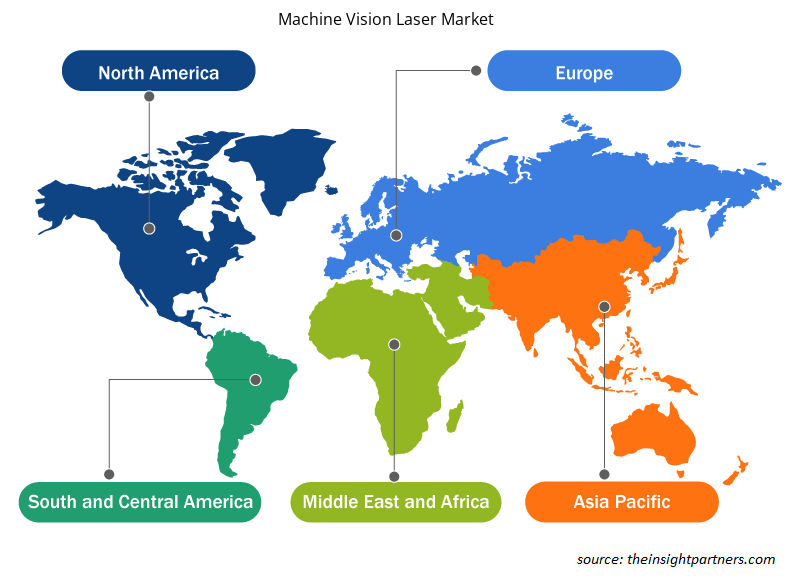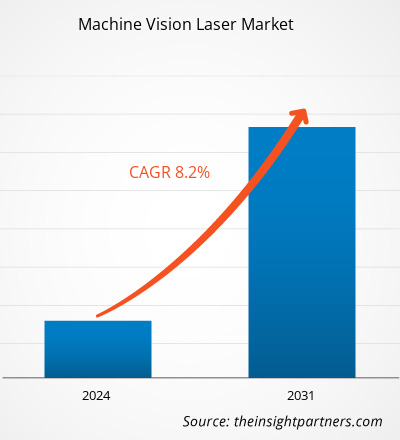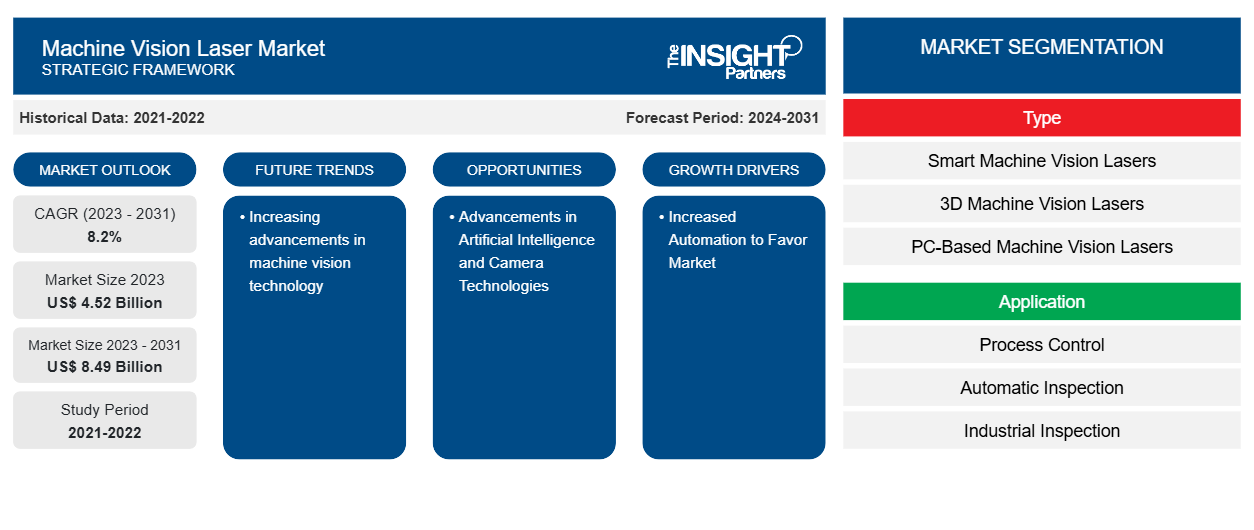Der globale Markt für Bildverarbeitungslaser soll von 4,52 Milliarden US-Dollar im Jahr 2023 auf 8,49 Milliarden US-Dollar im Jahr 2031 wachsen; von 2024 bis 2031 wird eine durchschnittliche jährliche Wachstumsrate von 8,2 % erwartet. Die zunehmenden Fortschritte in der Bildverarbeitungstechnologie werden voraussichtlich ein wichtiger Markttrend für Bildverarbeitungslaser bleiben.CAGR of 8.2% from 2024 to 2031. The increasing advancements in machine vision technology are likely to remain a key machine vision laser market trends.
Marktanalyse für Laser zur maschinellen Bildverarbeitung
Der steigende Bedarf an verbesserter Qualitätsprüfung und Automatisierung in verschiedenen Branchen dürfte das Marktwachstum ankurbeln.
Marktübersicht für Laser zur industriellen Bildverarbeitung
Lasersysteme für maschinelles Sehen (MV) verwenden Videokameras, digitale Signalverarbeitung und Analog-Digital-Umwandlung, damit Computer die Arbeitsleistung betrachten, untersuchen und bewerten können. Diese Systeme sammeln Daten, die anschließend zur Verarbeitung und Erstellung der erforderlichen Ausgabe an einen Computer gesendet werden . Auflösung und Empfindlichkeit sind zwei kritische Parameter in MV-Systemen. Die Auflösung bestimmt die Fähigkeit des Systems, zwischen Dingen zu unterscheiden. Gleichzeitig bezieht sich die Empfindlichkeit auf die Fähigkeit der Maschine, Objekte oder schwache Signale bei schlechten Lichtverhältnissen oder bei Wellenlängen zu identifizieren, die für das menschliche Auge unsichtbar sind. Diese Systeme sind für die Verwaltung von Arbeitsumgebungen von entscheidender Bedeutung, einschließlich Funktionen wie Prozesssteuerung, Roboterführung und automatisierte Inspektion in industriellen Anwendungen.MV) laser systems use video cameras, digital signal processing, and analog-to-digital conversion to let computers to view, examine, and assess job performance. These systems collect data, which is subsequently sent to a MV systems. Resolution determines the system's capacity to distinguish between things. At the same time, sensitivity refers to the machine's capacity to identify objects or weak signals in low-light settings or at wavelengths that are invisible to the human eye. These systems are critical in managing work environments, including functions such as process control, robotic guiding, and automated inspection in industrial applications.
Passen Sie diesen Bericht Ihren Anforderungen an
Sie erhalten kostenlos individuelle Anpassungen an jedem Bericht, einschließlich Teilen dieses Berichts oder einer Analyse auf Länderebene, eines Excel-Datenpakets sowie tolle Angebote und Rabatte für Start-ups und Universitäten.
- Holen Sie sich die wichtigsten Markttrends aus diesem Bericht.Dieses KOSTENLOSE Beispiel umfasst eine Datenanalyse von Markttrends bis hin zu Schätzungen und Prognosen.
Treiber und Chancen auf dem Markt für Laser zur industriellen Bildverarbeitung
Erhöhte Automatisierung kommt dem Markt zugute
Die Automatisierung erfreut sich in vielen Branchen zunehmender Beliebtheit, angetrieben durch den Wunsch nach mehr Effizienz und Qualitätskontrolle. Dieser Trend ist besonders in der Fertigung und Logistik zu beobachten. Der Einsatz von Automatisierungsprozessen hat zu einem erhöhten Bedarf an Bildverarbeitungssystemen, insbesondere laserbasierten Technologien, geführt, um diese automatisierten Abläufe zu verbessern. Der Einsatz von Automatisierung in Produktion und Logistik bietet mehrere Vorteile. Ein wichtiger Vorteil ist die bessere Kontrolle und Einheitlichkeit der Produktqualität. Automatisierte Systeme führen Produktionsabläufe oft mit geringerer Variabilität durch als menschliche Arbeiter und ermöglichen so eine bessere Kontrolle der Produktqualität.
Fortschritte in der künstlichen Intelligenz und Kameratechnologien
Fortschritte in der künstlichen Intelligenz (KI) und der Kameratechnologie haben das Wachstum und die Entwicklung des Marktes für maschinelles Sehen erheblich gefördert. Diese Verbesserungen haben die Fähigkeiten von Systemen für maschinelles Sehen verbessert und sie in einer Vielzahl von Anwendungen präziser und effizienter gemacht. Einer der bedeutendsten Fortschritte in der maschinellen Bildverarbeitung ist der zunehmende Einsatz von KI und Deep-Learning-Ansätzen. Algorithmen und Deep-Learning-Ansätze ermöglichen es Computern, aus Daten zu lernen und ihre Leistung selbstständig zu verbessern, ohne dass menschliches Eingreifen erforderlich ist. Dies hat zur Entwicklung immer komplexerer Systeme für maschinelles Sehen geführt, die Bilder oder Filme mit höherer Genauigkeit und Geschwindigkeit erkennen und analysieren können.
Segmentierungsanalyse des Marktberichts für maschinelles Sehen von Lasern
Schlüsselsegmente, die zur Ableitung der Marktanalyse für maschinelles Sehen mit Lasern hinsichtlich Typ, Anwendung und Endbenutzer beigetragen haben.
- Nach Typ ist der Markt in intelligente Bildverarbeitungslaser, 3D-Bildverarbeitungslaser und PC-basierte Bildverarbeitungslaser unterteilt. Das Segment der intelligenten Bildverarbeitungslaser hatte im Jahr 2023 einen größeren Marktanteil.
- Basierend auf der Anwendung ist der Markt in Prozesssteuerung, automatische Inspektion, industrielle Inspektion und andere unterteilt. Das Segment der automatischen Inspektionslaser hatte im Jahr 2023 einen größeren Marktanteil.
- Basierend auf dem Endverbraucher ist der Markt in die Bereiche Automobil, Elektronik und Halbleiter, Lebensmittel und Getränke, Pharmazeutika, Logistik und andere unterteilt. Das Automobilsegment hatte im Jahr 2023 einen größeren Marktanteil.
Marktanteilsanalyse für Machine Vision Laser nach geografischer Lage
Der geografische Umfang des Marktberichts für maschinelles Sehen mit Lasern ist hauptsächlich in fünf Regionen unterteilt: Nordamerika, Asien-Pazifik, Europa, Naher Osten und Afrika sowie Südamerika/Süd- und Mittelamerika. Nordamerika dominierte den Markt für maschinelles Sehen mit Lasern im Jahr 2023. Die steigende Nachfrage nach Automatisierung und die Integration fortschrittlicher Bildgebungstechnologien in einer Vielzahl von Branchen treiben den Markt für maschinelles Sehen mit Lasern in Nordamerika an. Darüber hinaus wird erwartet, dass der Fokus auf technologische Fortschritte durch wichtige Akteure auf dem Markt das Wachstum des Marktes für maschinelles Sehen mit Lasern vorantreiben wird. Zu diesen Fortschritten gehören die Entwicklung plattformunabhängiger Software, intelligenter Kameras, 3D-Sensoren und Bildverarbeitungssteuerungen.
Regionale Einblicke in den Markt für Laser zur maschinellen Bildverarbeitung
Die regionalen Trends und Faktoren, die den Markt für maschinelles Sehen mit Lasern während des Prognosezeitraums beeinflussen, wurden von den Analysten von Insight Partners ausführlich erläutert. In diesem Abschnitt werden auch die Marktsegmente und die Geografie für maschinelles Sehen mit Lasern in Nordamerika, Europa, im asiatisch-pazifischen Raum, im Nahen Osten und Afrika sowie in Süd- und Mittelamerika erörtert.

- Erhalten Sie regionale Daten zum Markt für Laser-Maschinensichtgeräte
Umfang des Marktberichts über Laser zur maschinellen Bildverarbeitung
| Berichtsattribut | Details |
|---|---|
| Marktgröße im Jahr 2023 | 4,52 Milliarden US-Dollar |
| Marktgröße bis 2031 | 8,49 Milliarden US-Dollar |
| Globale CAGR (2023 - 2031) | 8,2 % |
| Historische Daten | 2021-2022 |
| Prognosezeitraum | 2024–2031 |
| Abgedeckte Segmente | Nach Typ
|
| Abgedeckte Regionen und Länder | Nordamerika
|
| Marktführer und wichtige Unternehmensprofile |
|
Marktteilnehmerdichte: Der Einfluss auf die Geschäftsdynamik
Der Markt für Machine Vision Laser wächst rasant, angetrieben durch die steigende Nachfrage der Endnutzer aufgrund von Faktoren wie sich entwickelnden Verbraucherpräferenzen, technologischen Fortschritten und einem größeren Bewusstsein für die Vorteile des Produkts. Mit steigender Nachfrage erweitern Unternehmen ihr Angebot, entwickeln Innovationen, um die Bedürfnisse der Verbraucher zu erfüllen, und nutzen neue Trends, was das Marktwachstum weiter ankurbelt.
Die Marktteilnehmerdichte bezieht sich auf die Verteilung der Firmen oder Unternehmen, die in einem bestimmten Markt oder einer bestimmten Branche tätig sind. Sie gibt an, wie viele Wettbewerber (Marktteilnehmer) in einem bestimmten Marktraum im Verhältnis zu seiner Größe oder seinem gesamten Marktwert präsent sind.
Die wichtigsten auf dem Markt für Laser zur industriellen Bildverarbeitung tätigen Unternehmen sind:
- Cavitar Ltd.
- Cognex Corporation
- Laser Components GmbH
- Laserex
- Keyence Corporation
- ProPhotonix
Haftungsausschluss : Die oben aufgeführten Unternehmen sind nicht in einer bestimmten Reihenfolge aufgeführt.

- Überblick über die wichtigsten Akteure auf dem Markt für maschinelles Sehen mit Lasern
Neuigkeiten und aktuelle Entwicklungen zum Markt für maschinelles Sehen mit Lasern
Der Markt für maschinelles Sehen mit Lasern wird durch die Erhebung qualitativer und quantitativer Daten nach Primär- und Sekundärforschung bewertet, die wichtige Unternehmensveröffentlichungen, Verbandsdaten und Datenbanken umfasst. Im Folgenden finden Sie eine Liste der Entwicklungen auf dem Markt:
- Im Oktober 2023 stellte Keyence Corporation die VS-Serie vor, eine neue Reihe intelligenter Kamera-Vision-Systeme. Dieses System ist benutzerfreundlich konzipiert und erfordert weder ein Bedienfeld noch Software zur Überprüfung von IP-Adressen und Verbindungen. Es ist nach IP67 zertifiziert und verfügt über mehrere Funktionen, die seine Funktionalität verbessern. Zu diesen Funktionen gehören ein integrierter Laserpointer, vier Montagelöcher für flexible Installationskonfigurationen und Unterstützung für Power over Ethernet, wodurch sowohl die Kamera als auch das Licht über ein einziges Ethernet-Kabel mit Strom versorgt werden können.
(Quelle: Keyence Corporation, Pressemitteilung, 2023)
Marktbericht zu Lasern für maschinelles Sehen – Umfang und Ergebnisse
Der Bericht „Marktgröße und Prognose für maschinelles Sehen mit Lasern (2021–2031)“ bietet eine detaillierte Analyse des Marktes, die die folgenden Bereiche abdeckt:
- Marktgröße und Prognose auf globaler, regionaler und Länderebene für alle wichtigen Marktsegmente, die im Rahmen des Projekts abgedeckt sind
- Marktdynamik wie Treiber, Beschränkungen und wichtige Chancen
- Wichtige Zukunftstrends
- Detaillierte PEST/Porters Five Forces- und SWOT-Analyse
- Globale und regionale Marktanalyse mit wichtigen Markttrends, wichtigen Akteuren, Vorschriften und aktuellen Marktentwicklungen
- Branchenlandschaft und Wettbewerbsanalyse, einschließlich Marktkonzentration, Heatmap-Analyse, prominenten Akteuren und aktuellen Entwicklungen
- Detaillierte Firmenprofile
- Historische Analyse (2 Jahre), Basisjahr, Prognose (7 Jahre) mit CAGR
- PEST- und SWOT-Analyse
- Marktgröße Wert/Volumen – Global, Regional, Land
- Branchen- und Wettbewerbslandschaft
- Excel-Datensatz
Aktuelle Berichte
Verwandte Berichte
Erfahrungsberichte
Grund zum Kauf
- Fundierte Entscheidungsfindung
- Marktdynamik verstehen
- Wettbewerbsanalyse
- Kundeneinblicke
- Marktprognosen
- Risikominimierung
- Strategische Planung
- Investitionsbegründung
- Identifizierung neuer Märkte
- Verbesserung von Marketingstrategien
- Steigerung der Betriebseffizienz
- Anpassung an regulatorische Trends





















 Kostenlose Probe anfordern für - Markt für Laser zur maschinellen Bildverarbeitung
Kostenlose Probe anfordern für - Markt für Laser zur maschinellen Bildverarbeitung